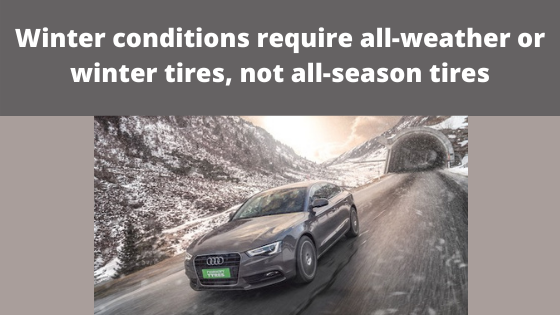When it comes to winter tires, they have actually passed stringent tests to achieve approval so that they can be used during winter conditions. This is symbolized by the severe service emblem aka snowflake (3PMSF) symbol. This is different than the M+S marking that you sometimes can see on tires that basically just indicates that the tread design is made to manage to cope with these conditions without any actual performance criteria.
When it comes to tires that are approved for winter use, you have two winter tires, studded and non-studded, that you need to combine with all-season tires during the warm season. You also have a all-year round tires that are approved for winter use, so that you can keep one set of tires on your vehicle the whole year. Which can be a benefit sometimes. All tires that are approved for winter use, should have good grip in winter conditions. If you have problems it might be that you have low quality tires that doesn’t use the latest tire technologies to create grip.
If you don’t have sufficient grip on ice, it might be that you should use studded tires instead of non-studded tires. Studded tires aren’t allowed in every State and Province in North America, but in the places they are allowed they can be used to improve the grip especially on ice. This can be necessary in areas that have very icy roads, that can often happen in areas close to big lakes or by the coast. If studded tires aren’t allowed you will need to choose a set oof premium non-studded tires that have incorporated all the latest tire technologies into the tread, sipes and the rubber compound. They all three have to work together to achieve the best possible grip on snow, ice and slush without using studs. The incorporation of Cryo crystals as gripping particles and special sipes that can grip the ice, you can create almost similar grip on ice as the studded tires.
This is very convenient for areas that have more changing weather and maybe not a full on winter season. It can also be perfect for areas that can visit different type of weather conditions during the same day. Where you can actually take the car up to ski resort or then to the beach by just driving different directions. This would otherwise require a change of tires to remain safe on the road, but with all-weather tires you can safely visit any are regardless of weather conditions. If you instead have long and harsh winter conditions you are better of having winter tires and making sure that you change tires in time before the first snow arrives so that you can drive safely from the start of the winter season. If not then all-weather tires will always be a safer option.
For more information regarding where you can get winter tires that has proven good grip on all winter surfaces, visit: www.nokiantires.com
